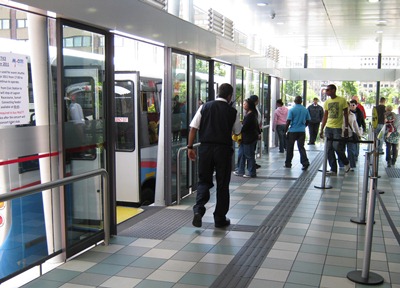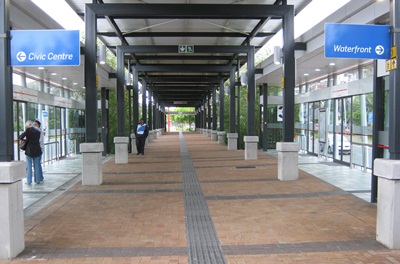
On Wednesday 26 October 2011 my wife and I took one of the new MyCiTi buses from Cape Town's city centre to Table View, a suburb some 25 kilometres to the north of the city. This route is part of Cape Town's ambitious new Integrated Rapid Transit (IRT) system, whereby buses travelling in dedicated lanes will supplement the existing commuter rail network. The IRT system is still under construction and the Cape Town-Table View service was the second route to open ; the first was the non-stop service from the city centre to the airport, which had been launched on 29 May 2010 (just prior to the start of the 2010 Football World Cup in South Africa) [Aside : The City of Cape Town's MyCiTi bus web site can be found here].


The main IRT bus station in the city centre (called the "Civic Centre Station") is situated on Hertzog Boulevard, next to the Artscape theatre and a five-minute walk from Cape Town's train station. Hertzog Boulevard is a busy 6-lane road, and the bus station has been constructed on the wide median strip in the middle with dedicated bus lanes on either side of the station. The bus station is modern, attractive and spacious, but still incomplete - it is being extended to accommodate the future expansion of the service.
Tickets to Table View were R10 each (ten SA Rands, a little more than one US Dollar) and we only had to wait a few minutes before the next bus arrived. I watched the procedure with interest and was very impressed with how it works. The station has been built like a train station, with platforms well above the road and level with the floor of the bus so that you don't step down or up but straight onto the bus. In addition, the IRT station platforms are entirely enclosed by glass with two sets of sliding doors that line up exactly with corresponding doors on the buses - when our bus arrived the platform doors and bus doors remained closed until the bus came to a complete halt and the doors were aligned ; only then did they open. After both sets of doors had opened a ramp slid out to bridge the gap between the platform and the floor of the bus, resulting in a smooth, even passage between the two. Even elderly, disabled or wheelchair-bound passengers would have no difficulty boarding or disembarking. All passengers alighting from the bus got off first and exited before people wanting to board were allowed on.
The bus itself comprised two coaches, joined by a flexible cowl that enabled easy navigation round tight corners. It was bright, airy and modern inside, with sturdy vandal-resistent seats and yellow "grab poles". I noticed that smoking, eating and drinking is not permitted on buses or on stations, which will be a major factor in ensuring that the entire system stays clean and user-friendly (the Gautrain has a similar rule).

We headed east out of the city on Hertzog Boulevard, but quickly turned off onto old Marine Drive, under the N2 freeway and alongside the tracks and sidings of the Culemborg railway yard. I had never been in this area before (it has always been closed to the public), but it was obvious that the road we were on was very new and dedicated solely to MyCiTi buses because we didn't see a car at all for several kilometres. We were travelling next to the Cape Town-Monte Vista suburban railway line and Esplanade train station passed by on our right, with the N1 freeway visible to the left. Just past the point where Marine Drive (the R27) branched off the N1 national road our bus headed onto a new bridge which crossed over the N1, the railway tracks and the polluted water of the Salt River. In the industrial suburb of Paarden Island the bus route continued northwards on another dedicated road between the busy arteries of Marine Drive and Koeberg Road [Aside : "Paarden Island" is not an island, merely an area of factories and warehouses just east of Cape Town].

At first I couldn't understand how a wide, two-lane road for use by buses only had been created through this congested area, but then I remembered that there was an old, disused railway line running down the middle of Paarden Island and when I looked at my map I saw that this is where the new bus route goes. The old railway tracks have either been lifted or paved over, and considerable effort has gone into greening the formerly bleak surroundings. No cars are allowed, but both pedestrians and cyclists are catered for. So a dedicated bus route has been constructed through a busy industrial suburb with no absolutely no effect on the surrounding roads ; very clever.
The bus made several stops at newly-constructed stations in Paarden Island before veering left onto Marine Drive at the corner of Milner Road. For the first time we were now travelling on a road used by other vehicles, but even then special provision has been made for buses. At certain intersections and at the stations there are complicated sets of traffic lights that allow buses to enter the flow of traffic without disruption or accidents - the "car only" lights are synchronized with the "bus only" lights.
Our route continued northwards on Marine Drive, with stops at Lagoon Beach, the densely-populated Woodbridge Island and Milnerton. Beyond Milnerton two special lanes have been constructed for buses on Marine Drive on either side of the median strip, with stations in the median strip so that buses can stop next to them without disrupting traffic. These bus lanes are not surfaced with conventional black tar but with some reddish-brown material, making them extremely visible and obvious to motorists.


We passed Milnerton Lagoon (the Rietvlei Nature Area) and shortly arrived in the centre of Table View. The bus turned onto Blaauwberg Road (road number M14, the main east-west route) and stopped at the Table View bus station, built on the traffic island in the middle of this busy thoroughfare and directly between the Bayside Shopping Centre and the Pick 'n Pay Shopping Centre. We disembarked and wandered across the road, looking for somewhere to get a caffeine fix.
Table View is currently the last stop for MyCiTi buses, but looking up Marine Drive you can clearly see that the dedicated bus lanes are being extended northwards towards Blouberg, Sunningdale and Melkbos. The suburbs north of Table View are probably the fastest-growing in the whole of the Western Cape, so there's no doubt that an extended service will be extremely well-supported, particularly because the bulk of the people living in this area are young families with one (or two) adults commuting to work every day. As it is, Marine Drive (the R27) is completely choked with traffic early in the morning (commuters heading into Cape Town) and late afternoon (the same people returning home). Although we did the trip described above during the middle of the day, by all accounts the MyCiTi buses are packed during rush-hour - indicating that at least the Cape Town-Table View IRT route is already a success. In fact, towards the end of 2011 more buses were added to the peak-hour schedule to cater for the demand.
Overall, my impressions of the MyCiTi bus service are: © Paul Kilfoil, Cape Town, South Africa
© Paul Kilfoil, Cape Town, South Africa